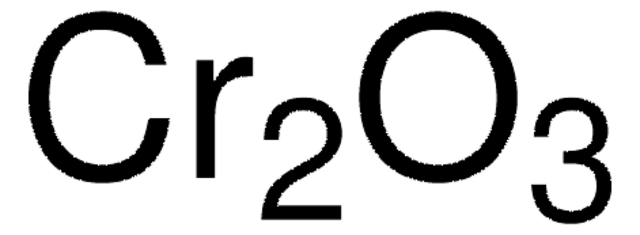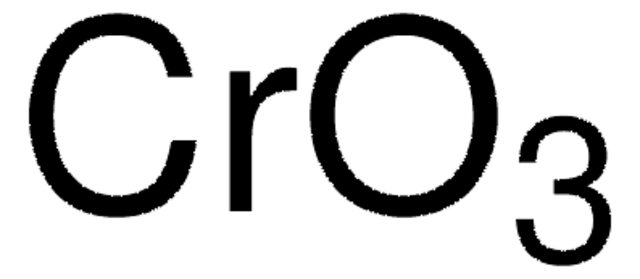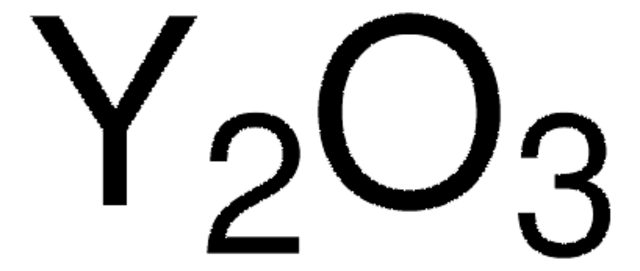393703
Chromium(III) oxide
powder, ≥98%
Synonyme(s) :
Chromia
Se connecterpour consulter vos tarifs contractuels et ceux de votre entreprise/organisme
About This Item
Formule empirique (notation de Hill):
Cr2O3
Numéro CAS:
Poids moléculaire :
151.99
Numéro CE :
Numéro MDL:
Code UNSPSC :
12352303
ID de substance PubChem :
Nomenclature NACRES :
NA.55
Essai:
≥98%
Forme:
powder
Produits recommandés
Niveau de qualité
Essai
≥98%
Forme
powder
Chaîne SMILES
O=[Cr]O[Cr]=O
InChI
1S/2Cr.3O
Clé InChI
QDOXWKRWXJOMAK-UHFFFAOYSA-N
Vous recherchez des produits similaires ? Visite Guide de comparaison des produits
Description générale
Chromium (III) oxide is a chromium complex in which the chromium ion is in +3 oxidation state. The synthesis of its sub-micron powder has been reported.† The IR and Raman spectra of chromium (III) oxide have been studied.† The impact of adding lysozyme on the stability of chromium (III) oxide (Cr2O3) suspension has been evaluated.†
Application
Chromium (III) oxide may be used in the following processes:
- To modify carbon paste electrodes for optimizing its ability to detect nitric oxide.
- Preparation of Ni+Cr2O3 composite coatings.
- Formation of the ternary oxide, CrVMoO7 by solid-state reaction which may be employed in selective oxidation reactions.
Used in a solid-state reaction to form the new ternary oxide, CrVMoO7, can be used in selective oxidation.
Code de la classe de stockage
11 - Combustible Solids
Classe de danger pour l'eau (WGK)
nwg
Point d'éclair (°F)
Not applicable
Point d'éclair (°C)
Not applicable
Faites votre choix parmi les versions les plus récentes :
Déjà en possession de ce produit ?
Retrouvez la documentation relative aux produits que vous avez récemment achetés dans la Bibliothèque de documents.
Les clients ont également consulté
Crystal Structure and Raman Spectroscopy of FeVMoO7 and CrVMoO7 with Mo=O Double Bonds.
Wang, X. et al.
Inorganic Chemistry, 37(13), 3252-3252 (1998)
Amperometric Nitric Oxide Sensor Based on Carbon Paste Electrode Modified with Chromium (III) Oxide.
Berisha LS, et al.
Sensors & Transducers Journal, 184(1), 1726-5479 (2015)
The Hydrogen Evolution Reaction on Ni Electrode Material Modified with Molybdenum (IV) Oxide and Chromium (III) Oxide Powders.
Popczyk M and Losiewicz B.
Solid State Phenomena, 228 (2015)
Nien-Hsun Li et al.
Journal of hazardous materials, 198, 356-361 (2011-11-15)
The feasibility of stabilizing nickel-laden sludge by a high-temperature NiCr(2)O(4) synthesis process was investigated with different sintering temperatures, salt contents, molar ratios, and reaction atmospheres. The crystalline phases of species were investigated by using an X-ray diffraction, and the surface
Selvam Sangeetha et al.
Colloids and surfaces. B, Biointerfaces, 100, 36-41 (2012-07-07)
Stabilization of collagen for various applications employs chemicals such as aldehydes, metal ions, polyphenols, etc. Stability against enzymatic, thermal and mechanical degradation is required for a range of biomedical applications. The premise of this research is to explore the use
Notre équipe de scientifiques dispose d'une expérience dans tous les secteurs de la recherche, notamment en sciences de la vie, science des matériaux, synthèse chimique, chromatographie, analyse et dans de nombreux autres domaines..
Contacter notre Service technique







